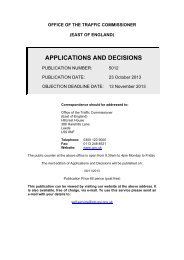2001_000
2001_000
2001_000
Create successful ePaper yourself
Turn your PDF publications into a flip-book with our unique Google optimized e-Paper software.
University of Leicester Archaeological Services<br />
Above: some of the<br />
items found in the<br />
graves.<br />
and the remnants of some external mortared walls were<br />
also visible. Unfortunately, much of this structure had been<br />
destroyed by a modern farm building. Few datable finds<br />
were recovered although some fragments of floor tiles<br />
(similar to those found in the grave) were identified. It is,<br />
however, uncertain whether the 14th-century tile fragments<br />
were contemporary with the structure or whether they had<br />
been incorporated into its fabric at a later date. Additional<br />
cobble structures, including a long enclosure wall, were also<br />
identified within the excavation area.<br />
recovered from the grave fills. One individual was found to<br />
be wearing a very plain ‘penannular’ style brooch,<br />
commonly used as a fastening for clothing, while another<br />
was found with six 14th-century floor tiles, four of which<br />
were decorated with the Arms of Beauchamp. Although<br />
most of the burials appeared to be simple interments, without<br />
coffins (the bodies may simply have been wrapped in<br />
shrouds that have since rotted), one burial was found to<br />
incorporate a wooden coffin held together with iron nails.<br />
Interestingly this coffin burial was also the only double<br />
interment, found in ‘double-decker’ style below the burial<br />
containing the tiles.<br />
Detailed laboratory analysis of the skeletons indicated that<br />
the population consisted primarily of mature adult males,<br />
bearing the obvious signs of old age; arthritis was very<br />
common. Only one female and one juvenile, of 15 years,<br />
broke the trend.<br />
To the south-west of the cemetery area, a simple track<br />
was identified running in a north-west to south-east direction.<br />
This made use of small rounded pebbles embedded in clay,<br />
presumably to stabilise the ground and to prevent rutting by<br />
cartwheels. This track may have led from the hospital<br />
buildings to the cemetery.<br />
Adjacent to the pebble track lay a large cluster of cobbles<br />
which appeared to form the internal flooring of a cobble<br />
building, built in a similar style to the local parish church. A<br />
slate-lined drainage channel could be seen below the floor<br />
Above: the cobble-built structure and floor.<br />
A great deal of analytical work on the finds from the site at<br />
Mill Farm remains to be completed, and it is hoped that in<br />
the near future a more detailed picture may be formed of<br />
the nature of these remains. What is already apparent is<br />
that the latest excavations have succeeded in locating at<br />
least part of the lost hospital of St. John’s.<br />
We would like to thank Hallam Land Management for their<br />
help and co-operation with this project.<br />
11





